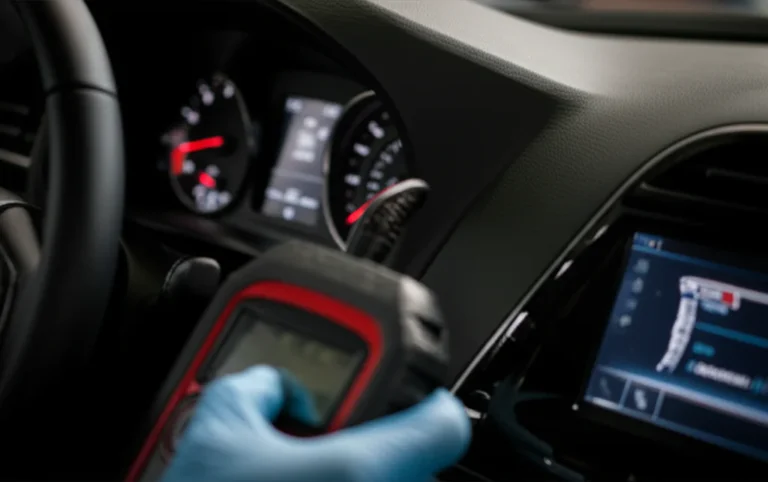Support our educational content for free when you purchase through links on our site. Learn more
10 Warning Signs Your Car Needs Repairs 🚗 (2025 Guide)
Have you ever been cruising down the highway when suddenly your dashboard lights up like a Christmas tree or your car starts making a strange noise that you just can’t ignore? You’re not alone. Many drivers overlook these subtle—and sometimes not-so-subtle—warning signs, only to face costly repairs or, worse, dangerous breakdowns. At Car Brands™, we’ve seen firsthand how recognizing these signals early can save you thousands and keep you safe on the road.
Did you know that nearly 70% of car breakdowns could be prevented by paying attention to dashboard warning lights and unusual noises? In this comprehensive guide, we’ll decode those mysterious dashboard symbols, help you identify the sounds your car makes when it’s in distress, and share real-life stories that prove why ignoring these signs is a gamble you don’t want to take. Plus, we’ll reveal how modern tech like OBD-II scanners can turn you into your own car detective!
Key Takeaways
- Dashboard warning lights are your car’s first line of communication—learn to recognize critical symbols like the Check Engine, Oil Pressure, and Battery lights.
- Unusual noises such as squealing, grinding, or knocking often signal urgent repairs—don’t ignore them!
- Physical symptoms like vibrations, pulling, and fluid leaks are red flags that something needs immediate attention.
- Using OBD-II scanners and apps empowers you to diagnose issues early and avoid costly repairs.
- Preventative maintenance is the best way to avoid sudden breakdowns and expensive fixes.
- Know when to DIY and when to call a professional mechanic to keep your car safe and reliable.
Ready to become a car whisperer and catch problems before they catch you? Dive into our expert insights and get your ride running smoothly for years to come!
👉 Shop OBD-II Scanners and Diagnostic Tools:
- BlueDriver on Amazon | BlueDriver Official Website
- Autel Scanners on Amazon | Autel Official Website
- FIXD Sensor on Amazon | FIXD Official Website
Table of Contents
- ⚡️ Quick Tips and Facts: Spot Your Car’s SOS Signals Early
- 🔧 The Lowdown on Car Warning Signs: Why They Matter
- 1️⃣ Dashboard Warning Lights Decoded: What Each Symbol Means
- 2️⃣ Unusual Noises Under the Hood and Beyond: Your Car’s Cry for Help
- 3️⃣ Physical and Performance Warning Signs: When Your Car Feels Off
- 4️⃣ The Role of Technology: Using OBD-II Scanners and Apps to Diagnose Problems
- 5️⃣ When to DIY and When to Call the Pros: Repair Decisions Made Easy
- 6️⃣ Preventative Maintenance: How to Avoid Warning Signs Before They Start
- 7️⃣ Real-Life Stories: How Ignoring Warning Signs Led to Costly Repairs
- Conclusion: Stay Ahead of Car Trouble with These Expert Tips
- Recommended Links for Car Care and Diagnostics
- FAQ: Your Burning Questions About Car Warning Signs Answered
- Reference Links: Trusted Sources for Further Reading
Here is the main content for your article, crafted by the experts at Car Brands™.
⚡️ Quick Tips and Facts: Spot Your Car’s SOS Signals Early
Welcome, fellow gearheads and daily drivers! Before we dive deep into the symphony of clunks, whirs, and mysterious glowing lights that our cars serenade us with, let’s get you the fast and furious version. Think of this as your cheat sheet to automotive first aid. Here at Car Brands™, we believe that understanding the basics of car repairs can save you a world of hurt (and cash!).
- Listen Up! 👂 Your car communicates through sound. A squeal often points to belts or brakes, a grind is a classic bad brake pad sign, and a knock from the engine is a demand for immediate attention. As the pros at My Mechanic Joe say, “If something sounds off, it probably is.”
- Dashboard Lights are Not Decorations ✨: That little glowing symbol is your car’s way of texting you. A flashing Check Engine Light is a Code Red—pull over safely! A steady light is less urgent but still needs checking. We’ll decode them all below.
- Follow Your Nose 👃: Your sense of smell is a powerful diagnostic tool. A sweet, syrupy smell could be a coolant leak, while a rotten egg aroma often signals a catalytic converter issue. “Your nose is one of the best tools for detecting early issues with your vehicle,” and we couldn’t agree more.
- Feel the Drive 🚗: Is your car pulling to one side? Vibrating at certain speeds? These are not new “features.” They often point to tire, alignment, or suspension problems.
- Look for Leaks 💧: Puddles under your car are a tell-tale sign. Reddish-pink fluid is likely transmission fluid, while green or orange is usually coolant. “You may notice spots of reddish or pinkish fluid beneath your vehicle,” which is a clear sign to investigate.
🔧 The Lowdown on Car Warning Signs: Why They Matter
Alright, let’s have a real heart-to-heart. Ignoring your car’s warning signs is like ignoring a toothache. Sure, you can live with it for a little while, but eventually, it’s going to become a massive, expensive, and painful problem. Your vehicle is a complex machine, a beautiful beast of engineering, but it can’t fix itself. Those little signs are its only way of crying for help before a minor issue snowballs into a catastrophic failure.
Think of it this way: a tiny, inexpensive seal that starts to leak can, over time, drain a critical fluid. This can lead to “full transmission failure or overheating of your engine over time.” That’s the difference between a simple fix and a repair bill that could finance a small vacation. Paying attention doesn’t just save you money; it’s a crucial safety measure. A brake system that feels “spongy” or pulls to one side isn’t just an annoyance; “it’s a safety risk.”
Here at Car Brands™, we’ve seen it all. From stubborn drivers who thought a knocking engine would “work itself out” (spoiler: it didn’t) to those who saved thousands by simply addressing a warning light early. We’re here to help you become the kind of car owner who’s in tune with their ride, not one who’s left stranded on the side of the road.
1️⃣ Dashboard Warning Lights Decoded: What Each Symbol Means
Your car’s dashboard can sometimes light up like a Christmas tree, and it’s rarely a cause for celebration. These lights are your car’s primary communication system, designed to “prevent small problems from becoming big ones.” Let’s break down what they’re trying to tell you.
For a great visual guide, the YouTube video embedded in this article is a fantastic resource. The host does a brilliant job of explaining these symbols in a clear, concise way that we highly recommend checking out after you’re done here. You can jump straight to it by clicking this link: #featured-video.
Common Critical Lights: Engine, Oil, Battery, and More
These are the big ones. When you see one of these, it’s time to pay immediate attention.
| Light Symbol | Name | What It Means | What to Do |
|---|---|---|---|
| 엔진 | Check Engine Light | The most infamous light! It can mean anything from a loose gas cap to a serious engine misfire. A steady light means get it checked soon. A flashing light means pull over safely and call for a tow—continuing to drive could cause severe damage. | |
| ⛽️ | Oil Pressure Warning | This indicates a loss of oil pressure, which is critical for engine lubrication. It could be low oil level or a failing oil pump. | Stop the car immediately! Driving without proper oil pressure can destroy your engine in minutes. |
| 🔋 | Battery/Charging Alert | Your car’s electrical system is on the fritz. This could be a dead battery, a faulty alternator, or a broken belt. | Your car will run until the battery dies. Head to a mechanic ASAP. Avoid using electrical accessories like the radio. |
| 🌡️ | Coolant Temperature Warning | Your engine is overheating! This is a serious problem that can lead to warped engine components and a massive repair bill. | Pull over safely, turn off the engine, and let it cool down completely. Do not open the radiator cap when it’s hot. |
Less Urgent but Important Lights: ABS, Tire Pressure, and Traction Control
These lights typically signal issues with safety and performance systems. While you can usually continue driving, you should get them checked out promptly.
- ✅ Anti-lock Braking System (ABS) Light: This means there’s a fault in your ABS. Your regular brakes will still work, but the anti-lock feature won’t engage in an emergency stop. Get it inspected, especially before driving in wet or icy conditions.
- ✅ Tire Pressure Monitoring System (TPMS) Light: One or more of your tires is significantly under-inflated. This affects handling, fuel economy, and can lead to a blowout. Check your tire pressures and inflate them to the recommended PSI found on the sticker inside your driver’s door jamb.
- ✅ Traction Control/Stability Control Light: This light will flash during normal operation when the system is actively preventing wheel spin (like on a slippery road). If it stays on steadily, the system has a fault and is deactivated.
2️⃣ Unusual Noises Under the Hood and Beyond: Your Car’s Cry for Help
Ever turn down the radio just to make sure that weird sound you thought you heard is real? We’ve all been there. Noises are one of the most common signs of trouble, and learning to identify them can make you a car-whisperer.
Squealing, Grinding, Knocking: What Those Sounds Mean
Let’s translate your car’s cacophony into plain English.
- High-Pitched Squealing During Acceleration: This is often a worn or loose serpentine belt or accessory belt. These belts run crucial components like your alternator and water pump. “Ignoring them can lead to bigger, more expensive problems” if one snaps.
- Scraping or Grinding When You Brake: ❌ This is a huge red flag. It almost always means your brake pads are completely worn out, and now you have metal grinding against metal. “Ignoring this sign can lead to more serious damage to your brake system,” like ruining the rotors.
- Rhythmic Knocking or Tapping from the Engine: This sound often increases with engine speed. It can be a sign of low oil pressure or, more seriously, worn internal engine components like rods or pistons. This is one of the scariest sounds a car can make—get it checked immediately.
- Hissing from Under the Hood: This could be a vacuum leak or a coolant leak hitting a hot engine part. A hissing sound can be a precursor to overheating, so it’s worth investigating.
- Clunking When Going Over Bumps: This usually points to a problem with your suspension system, like worn-out shock absorbers, struts, or bushings.
How to Pinpoint Noise Sources Like a Pro
To help your mechanic (or yourself), try to play detective. Ask yourself these questions:
- When does it happen? Only when braking? When turning? When accelerating? When the car is cold?
- Where is it coming from? The front or back? The driver’s side or passenger’s side? From the engine bay or underneath the car?
- Does the speed matter? Does the noise get faster or louder as you speed up?
Giving your mechanic this information is like giving a doctor your specific symptoms—it makes diagnosis much faster and more accurate.
3️⃣ Physical and Performance Warning Signs: When Your Car Feels Off
Sometimes, the warning sign isn’t a light or a sound, but a feeling. Your connection to the road changes, and the car just doesn’t behave like it used to. These physical symptoms are just as critical as any dashboard light.
Vibrations, Pulling, and Steering Issues
- Vibrations in the Steering Wheel or Seat: If you feel a vibration that changes with your speed, the most likely culprit is your tires being out of balance. If the vibration happens during braking, it’s a strong indicator of warped brake rotors. As one expert notes, “vibrations are usually a sign that a part is wearing out or needs adjustment.”
- Car Pulling to One Side: When you’re driving straight but the car wants to drift left or right, that’s a classic sign of a wheel alignment issue. It can also be caused by uneven tire pressure or a stuck brake caliper. This isn’t just annoying; it causes premature tire wear and can be a safety hazard.
- “Spongy” or Soft Brake Pedal: If your brake pedal feels mushy or sinks towards the floor, you could have a leak in the brake system or air in the brake lines. This is a serious safety issue that needs immediate attention. Your brakes are not something to gamble on.
Smoke, Smells, and Fluid Leaks: Don’t Ignore These
Your senses of sight and smell are invaluable here. Let’s break down the evidence.
| Sign | Potential Cause | What It Means |
|---|---|---|
| Blue Smoke from Exhaust | Burning Oil | Oil is leaking past internal engine seals and into the combustion chamber. This can be caused by worn piston rings or valve seals. |
| White Smoke from Exhaust | Burning Coolant | This often indicates a serious issue like a blown head gasket, which allows coolant to enter the cylinders. It’s often accompanied by a sweet smell. |
| Black Smoke from Exhaust | Burning Too Much Fuel | Your engine is running “rich.” This could be a leaky fuel injector, a bad sensor, or a clogged air filter. It will ruin your fuel economy and can damage other components. |
| Sweet, Syrupy Smell | Coolant Leak | Antifreeze has a distinct sweet smell. You might smell it inside or outside the car. This often points to a leak in the radiator, a hose, or the heater core. |
| Burning Rubber Smell | Slipping Belt / Overheated Brakes | A slipping drive belt can create this smell. More seriously, if you smell it after heavy braking, your brakes could be overheating, a dangerous situation. |
| Rotten Egg Smell | Catalytic Converter Issue | This pungent, sulfurous smell almost always points to a failing catalytic converter, a key (and expensive) part of your exhaust system. |
Fluid leaks are another dead giveaway. Check your driveway for spots. As a reminder, reddish/pink is usually transmission fluid, green/orange/yellow is coolant, dark brown/black is engine oil, and clear could be water (A/C condensation, which is normal) or brake fluid (which is not).
4️⃣ The Role of Technology: Using OBD-II Scanners and Apps to Diagnose Problems
Feeling empowered yet? What if we told you that you could have a direct conversation with your car’s computer? Welcome to the world of On-Board Diagnostics (OBD-II). Every car made since 1996 has an OBD-II port, usually located under the dashboard on the driver’s side.
By plugging in an OBD-II scanner, you can read the specific Diagnostic Trouble Codes (DTCs) that triggered your Check Engine Light. Instead of just knowing “something is wrong,” you’ll get a code like “P0420,” which points to a specific issue (in this case, “Catalyst System Efficiency Below Threshold”).
Modern scanners from brands like BlueDriver, Autel, and FIXD are incredibly user-friendly. They often use Bluetooth to connect to an app on your smartphone, which not only gives you the code but also explains what it means in plain English and lists potential fixes.
This is a game-changer! It allows you to:
- Diagnose simple issues yourself (like that loose gas cap).
- Walk into the repair shop with more knowledge, preventing you from being taken advantage of.
- Reset the Check Engine Light after a repair is made.
Having one of these in your glove box is like having a mechanic on call 24/7. It’s one of the best investments any modern car owner can make.
👉 Shop OBD-II Scanners on:
- BlueDriver: Amazon | Walmart | BlueDriver Official Website
- Autel Scanners: Amazon | Walmart | Autel Official Website
- FIXD Sensor: Amazon | Walmart | FIXD Official Website
5️⃣ When to DIY and When to Call the Pros: Repair Decisions Made Easy
So you’ve used your senses and your fancy new OBD-II scanner to figure out what’s wrong. Now comes the big question: can you fix it yourself? As avid DIYers, we love getting our hands dirty, but we also know our limits. Here’s our guide to making the call.
✅ Go for it, DIY Warrior!
These tasks are generally safe for beginners with basic tools and a good YouTube tutorial.
- Checking and Topping Off Fluids: Oil, coolant, windshield washer fluid—easy peasy.
- Changing the Engine Air Filter: Usually just a few clips or screws. A 10-minute job that can improve performance.
- Replacing Wiper Blades: No tools required!
- Replacing a Burnt-Out Headlight or Taillight Bulb: On many cars, this is straightforward. (Though some, like certain Audi models, can make it surprisingly complex).
- Reading OBD-II Codes: As we just discussed, this is a must-do first step.
❌ Whoa There, Best to Call a Professional!
Attempting these without proper training and equipment can be dangerous or lead to much more expensive repairs.
- Brake Work: Your ability to stop is non-negotiable. “Increased stopping distance is a serious safety concern,” and brake work should be left to those who know exactly what they’re doing.
- Transmission Issues: Transmissions are incredibly complex. If you suspect a problem, from a leak to shifting issues, take it to a specialist.
- Engine Internal Repairs: If your issue involves knocking sounds or requires opening up the engine block, that’s pro territory.
- Suspension and Steering Work: This affects your car’s handling and requires special tools for alignment.
- Anything Involving Airbags or Major Electrical Systems: Just don’t. It’s not worth the risk.
The golden rule is: If you’re not 100% confident, don’t do it. There’s no shame in calling a trusted mechanic. It’s what they’re there for!
6️⃣ Preventative Maintenance: How to Avoid Warning Signs Before They Start
Want to know the real secret to a long-lasting, trouble-free car? It’s not some magic fuel additive or secret driving technique. It’s boring, old-fashioned preventative maintenance. Being proactive instead of reactive is the single best way to avoid seeing those dreaded warning lights in the first place.
Think of it like going to the doctor for a check-up instead of waiting for a heart attack. A little bit of care along the way prevents a world of pain later. Following your manufacturer’s recommended service schedule (found in your owner’s manual for your Ford, Toyota, or whatever you drive) is the best place to start.
Here’s a simple checklist of proactive steps you can take:
| Maintenance Task | Why It’s Important | Frequency |
|---|---|---|
| Regular Oil Changes | Keeps your engine lubricated, clean, and cool. The single most important thing you can do for your engine’s health. | Every 5,000-7,500 miles (or as per your manual). |
| Tire Rotation & Balancing | Ensures even tire wear, improves handling, and extends the life of your tires. Prevents vibrations. | Every 5,000-7,500 miles. |
| Fluid Checks | Regularly check your coolant, brake fluid, transmission fluid, and power steering fluid levels. Low levels are the first sign of a leak. | Monthly. |
| Brake Inspection | “Regular brake inspections are vital for your safety on the road.” Catching worn pads early prevents costly rotor damage. | At least once a year or with every oil change. |
| Battery Check | Have your battery and charging system tested, especially before winter. | Annually. |
Sticking to a schedule like this turns you from a car user into a car owner. You’ll be in tune with your vehicle and catch small problems before they leave you stranded.
7️⃣ Real-Life Stories: How Ignoring Warning Signs Led to Costly Repairs
We’ve been in the car world for a long time, and we’ve collected some… cautionary tales. These are true stories (names changed to protect the stubborn) from our team and community that prove why listening to your car is so important.
The Ticking Time Bomb
One of our reviewers, let’s call him Dave, had a trusty old Jeep Cherokee. It developed a faint ticking sound from the engine. It wasn’t loud, and the Jeep still ran fine, so he put it off. “It’s just an old engine,” he’d say. The ticking slowly got louder over a few months. One day on the highway, the ticking turned into a loud BANG, followed by a complete loss of power. The culprit? A collapsed lifter had finally given way, taking the camshaft with it. The “minor tick” turned into a multi-thousand-dollar engine rebuild. If he’d addressed it early, it would have been a much simpler, cheaper fix.
The Spongy Pedal Saga
Another team member, Sarah, was driving her Honda Accord in city traffic. She noticed the brake pedal felt a little… soft. It wasn’t failing, but she had to press it down further than usual to get the same stopping power. Many people might ignore this subtle change. But remembering that a spongy pedal is a sign of a potential leak, she drove straight to her mechanic. They found a corroded brake line that was weeping fluid—it was hours away from bursting completely. By catching that subtle “feeling,” she avoided a total brake failure in rush hour traffic. It was a stark reminder that “when it comes to brake issues, it’s better to be safe than sorry.”
These stories aren’t meant to scare you, but to empower you. By knowing what to look, listen, and feel for, you can write your own story—one with a much happier (and cheaper) ending.
Conclusion: Stay Ahead of Car Trouble with These Expert Tips
So, what have we learned on this journey through the warning signs your car sends when it needs repairs? Whether it’s a mysterious dashboard light flashing like a neon sign, an unusual noise that just won’t quit, or a strange feeling in the steering wheel, these are your car’s way of waving a red flag. Ignoring these signals is like ignoring a smoke alarm—it only leads to bigger, costlier, and sometimes dangerous problems.
Our expert advice from Car Brands™ is simple: listen, look, feel, and smell your car regularly. Use technology like OBD-II scanners to decode cryptic warning codes, but don’t hesitate to call in the pros when the issue is beyond your comfort zone. Preventative maintenance is your best friend—think of it as your car’s health insurance.
Remember the stories of Dave and Sarah? They prove that even subtle signs can precede major repairs. Don’t let your car’s SOS signals go unanswered. By staying vigilant and informed, you’ll enjoy a safer, smoother ride and save yourself from headaches down the road.
Ready to take control of your car’s health? Start with the simple steps we outlined, and keep this guide handy for when your car starts talking. Your ride will thank you!
Recommended Links for Car Care and Diagnostics
Here are some trusted products and brands to help you stay ahead of car troubles:
-
BlueDriver OBD-II Scanner:
Amazon | Walmart | BlueDriver Official Website -
Autel OBD-II Scanner:
Amazon | Walmart | Autel Official Website -
FIXD OBD-II Sensor:
Amazon | Walmart | FIXD Official Website -
Brake Pads and Rotors Replacement Parts:
Check your vehicle’s manufacturer site for OEM parts:
Ford | Toyota | Honda -
Car Brands™ Related Articles:
FAQ: Your Burning Questions About Car Warning Signs Answered
What do different dashboard warning lights mean on my car?
Dashboard warning lights are your car’s way of communicating issues. The Check Engine Light can indicate anything from a loose gas cap to serious engine problems. The Oil Pressure Light warns of dangerously low oil pressure, requiring immediate attention. The Battery Light signals charging system issues, while the Coolant Temperature Light means your engine is overheating. Other lights like ABS, TPMS, and Traction Control indicate safety system statuses. Always consult your owner’s manual for your specific vehicle’s symbols, and when in doubt, get a professional diagnosis.
Read more about “🚗 Top 10 Luxury Sedans with Advanced Technology (2025)”
How can I tell if my car’s engine is having problems?
Listen for unusual noises such as knocking, ticking, or hissing. Knocking often points to internal engine wear or low oil pressure, while hissing may indicate leaks. Watch for smoke colors from the exhaust—blue smoke means burning oil, white smoke suggests coolant leaks, and black smoke signals excess fuel burning. Performance issues like sluggish acceleration or stalling also hint at engine troubles. If you notice any of these, use an OBD-II scanner or visit a mechanic promptly.
Read more about “How Often Should I Schedule Car Repairs? 9 Expert Tips 🚗 (2025)”
What unusual noises indicate a need for car repairs?
- Squealing often means worn belts or brake pads.
- Grinding usually signals worn brake components.
- Knocking can indicate engine internal damage.
- Hissing may be a vacuum or coolant leak.
- Clunking when going over bumps points to suspension issues.
Pay attention to when and where these noises occur to help diagnose the problem.
Read more about “What Are the Average Costs of 10 Common Car Repairs? (2025) 🚗”
When should I take my car to a mechanic for inspection?
If you see flashing warning lights, experience a spongy brake pedal, notice persistent unusual noises, detect fluid leaks, or feel your car pulling or vibrating abnormally, it’s time to visit a mechanic. Also, if your OBD-II scanner returns serious trouble codes, or if you’re unsure about a symptom, professional inspection is the safest choice.
How do I recognize signs of brake system issues?
Signs include squeaking or grinding noises when braking, a soft or spongy brake pedal, brake warning lights on the dashboard, pulling to one side during braking, vibrations, and burning smells near the wheels. These symptoms indicate worn pads, fluid leaks, or rotor damage and require immediate attention to ensure safety.
What are common symptoms of transmission problems in a car?
Transmission issues often manifest as unusual noises during gear shifts, delayed or slipping shifts, transmission fluid leaks (reddish or pinkish spots under the car), burning smells, and dashboard warning lights like the Check Engine Light. Early detection and repair prevent costly transmission failure.
Read more about “Can You DIY Car Repairs? 12 Tasks to Tackle or Trust a Pro 🔧 (2025)”
How often should I check my car for potential repair needs?
Regular checks are essential. Inspect fluids monthly, tires and brakes every few thousand miles or at oil changes, and use an OBD-II scanner whenever a warning light appears. Following your manufacturer’s maintenance schedule is the best way to stay ahead of problems.
Read more about “Car Insurance Secrets: 6 Ways to Save Big! (2025) 💰”
Reference Links: Trusted Sources for Further Reading
- Bucholtz Transmission – Transmission Repair Warning Signs
- My Mechanic Joe – Warning Signs Your Car Needs a Check-Up
- Performance Topeka – Top Signs Your Car Needs a Brake Inspection
- National Highway Traffic Safety Administration (NHTSA) – Vehicle Safety
- Car and Driver – Understanding Your Car’s Dashboard Warning Lights
- BlueDriver Official Website
- Autel Official Website
- FIXD Official Website
For more expert insights and car brand comparisons, visit Car Brands™.
By keeping this guide close and your senses sharp, you’ll never miss a beat when your car calls for help. Safe driving! 🚗💨







